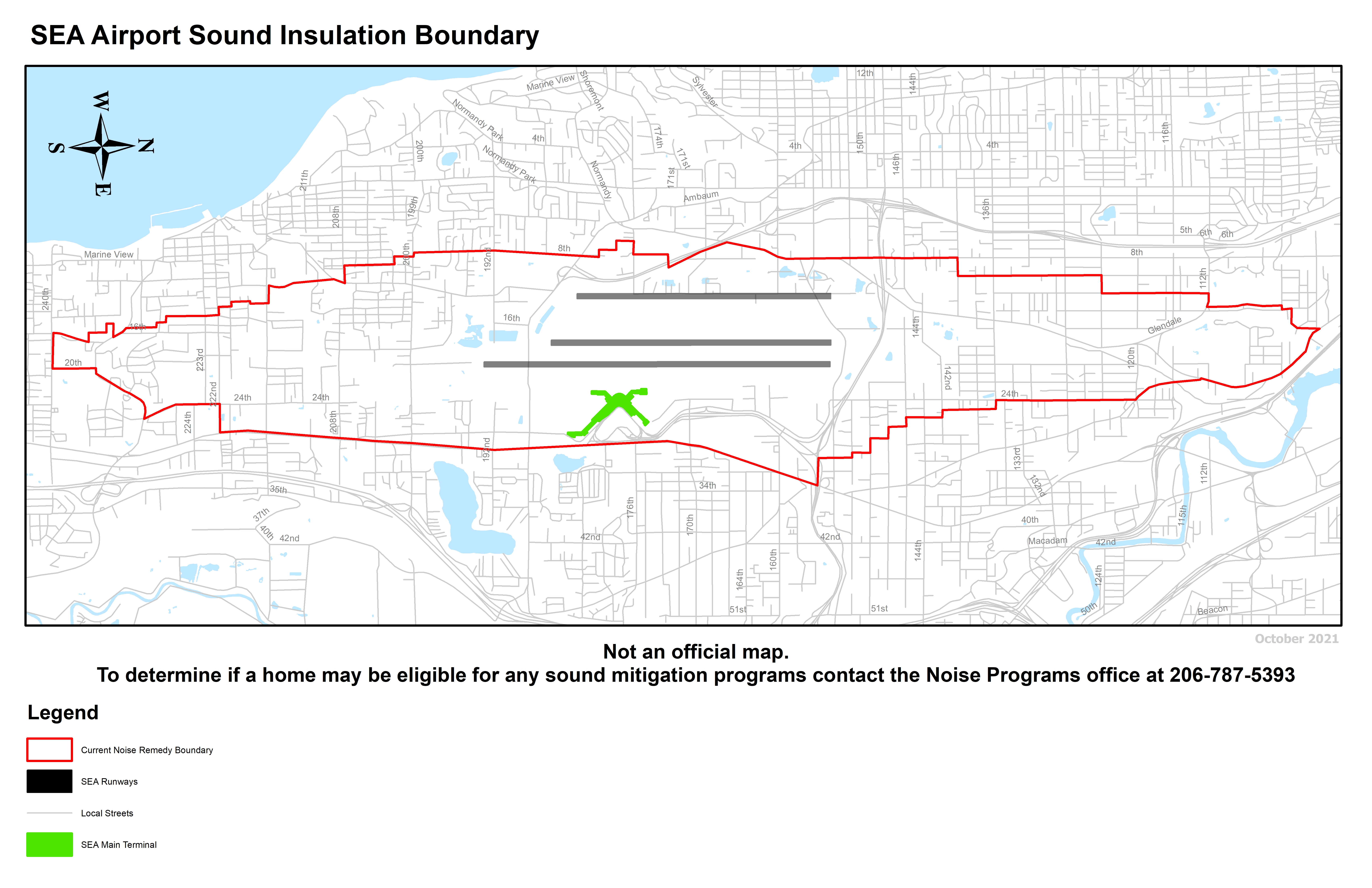*To use the "Search Answers" feature, type in a word in the box and then click the "Apply" button to the right.
*To use the "Search Answers" feature, type in a word in the box and then click the "Apply" button to the right.
Potentially eligible residences must be located inside Seattle-Tacoma International Airport’s (SEA) current Noise Remedy Boundary and have been built prior to the enactment of local building codes (in 1986 and 1987) that required the inclusion of sound insulation materials. The Federal Aviation Administration (FAA) requires that a home must also undergo interior noise testing to determine if it qualifies for the program.
The current Noise Remedy Boundary was established under FAA guidelines in 2014. To find more information regarding your home’s potential eligibility online at Eligibility | Port of Seattle (portseattle.org).
The Noise Remedy Boundary is established under FAA guidelines utilizing noise modeling and the required Day-Night average sound Level (DNL) noise metric. DNL is a 24-hour average (measured in decibels). Nighttime noise is weighted at a level 10 times that of daytime noise in calculating DNL.
The FAA has determined that a DNL level of at least 65 dB DNL is required before a home is potentially eligible for sound insulation. A 65 dB DNL noise contour is produced using sophisticated noise modelling, which is the FAA-required method, and this contour forms the basis for the Noise Remedy Boundary which aligns to street and cul-de-sac for neighborhood inclusion.

Acoustical treatments are determined by the Program Team, which evaluates the needs of each property individually. These treatments will be reviewed with Program staff for consistency with FAA guidelines. Proposed treatments will then be reviewed with each owner. All owners must agree in order to proceed.
You are required to complete the pre-work before the construction phase of the Program begins. We request you do not undertake any repairs or remodeling while the property is in the construction phase of the Program. Improvements or repairs that are not included in the sound insulation work being performed on the property are outside of the Program’s scope, are NOT covered, and may NOT occur from the time Program construction begins in your home until it is officially completed. Contractors hired by the Port are not eligible to make these repairs.
Construction in most properties are typically completed within 10 working days. Substantial completion is achieved when all products required under the base contract are installed but does NOT include “punch list” time (construction review and follow-up modifications).
The FAA and the Port of Seattle pay for the basic costs for labor and materials to install sound insulation treatments. If needed, the only costs to the homeowner would be to adjust or replace window dressings (blinds, draperies, etc.), address pre-work requirements or prepare the home for installation of the treatments. (if needed). The Port will pay the lender certain nominal fees charged to the reviewing and signing of Subordination Agreement documents and King County recording fees on the Avigation Easement and Subordination Agreement.
The work is bid out to insured, licensed and bonded general contractors. As a federally funded project, contractors are required to pay their employees Prevailing Wages and meet other Occupational Safety and Health Administration (OSHA) work standards.
You or an authorized designated representative aged 18 years or older should be present during the construction process.
You can expect the contractor to be in your property the entire day for an average of 10 working days. After they have reached substantial completion, the contractor will schedule appointments with you to finish the punch-list items or schedule a City permit inspection.
Improvements completed by the owner prior to participating in the Sound Insulation Program are not eligible for reimbursement.
The new windows are intended to provide a weather-tight, energy-efficient seal to make the property quieter and more comfortable. What you are most likely experiencing is condensation. Condensation occurs when water vapor meets a colder surface and transforms into its liquid state. Similar examples of condensation are steam from a shower fogging a bathroom mirror, or cold liquid forming water droplets on the outside of a glass on a hot day. The best solution is to address water vapor at its source by running bathroom and kitchen fans when using hot water.


© Copyright 2024 Port of Seattle. All Rights Reserved.